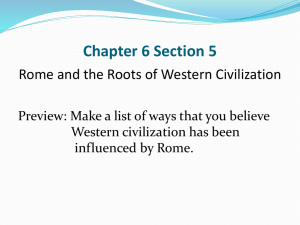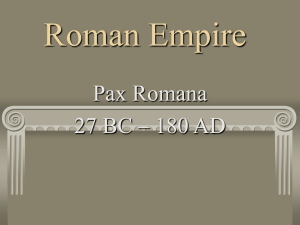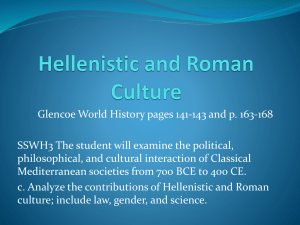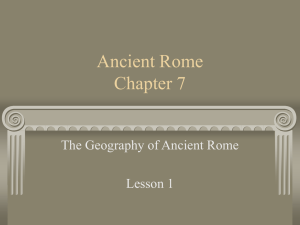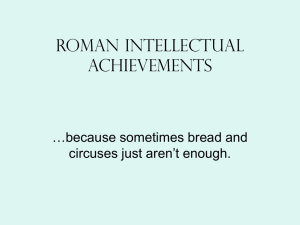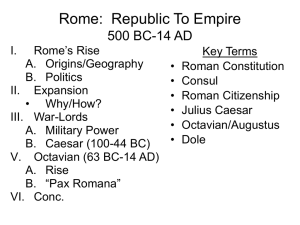Chapter 6, Roman Republic
advertisement
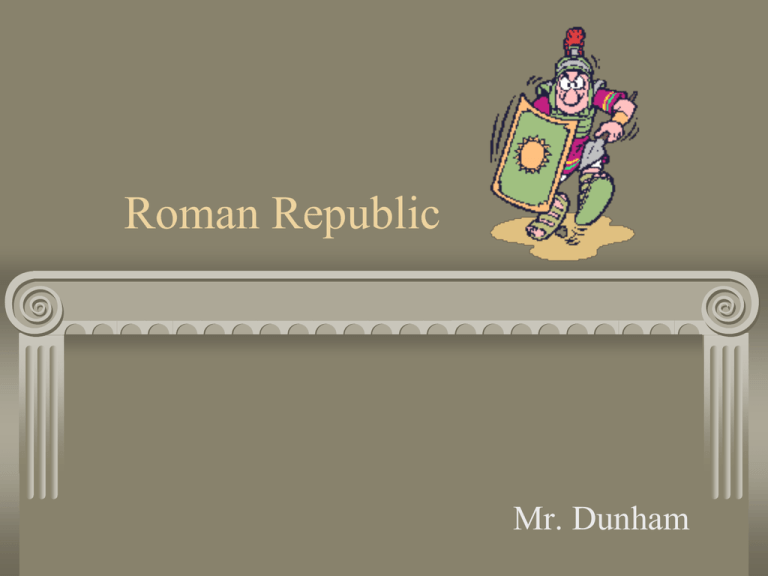
Roman Republic Mr. Dunham Geography Rome is located on the peninsula of Italy. The Mediterranean Sea provides transportation and food. Italy provides fertile plains and river valleys for food and easy communication. Roman Religious Ideals Romans were polytheistic, believing in many gods and spirits. Knowledge of the Greek Gods filtered into Roman culture. This is known as cultural diffusion. The Greek God Zeus became the almighty Roman God Jupiter. The Greek Goddess Hera became the Roman Goddess Juno. The Roman Republic Rome was founded about 509 BCE. Romans founded a new type of government called a republic. In a republic people chose officials to represent them. The highest form of government in Rome was the Senate. Senators were wealthy landowners (called Patricians.) The Roman Republic Cont… The senators elected two Consuls, whose job it was to run the government and command the army. Romans Valued Family Ties Roman families were headed by the eldest male. The Romans emphasized discipline, strength, and loyalty. Women had many rights and duties in Roman society. She did not, however have the key right, the right to vote. Officially, the Roman women were expected to remain in the background. Society was Divided Into Classes Upper class Romans were known as patricians. These people held nearly all the important political offices. Common framers, artisans, and merchants were known as plebeians. These two classes were based on birth alone. The line between the two classes was extremely rigid. Rome Built a Mighty Army Both patricians and plebeians lead double lives as farmers and soldiers because of the constant threat of war. All male citizens were required to serve in the army, and no one could hold public office until he served 10 years as a soldier. Rome Built a Mighty Army Massive military units were called legions. Which consisted of: Infantry: 4,000-6,000 Heavily armed foot soldiers. Cavalry: Smaller groups on horseback that assisted the infantry. Each legion was divided into 60 smaller groups called a century. A Fight with Carthage By 270 BC Rome had conquered all of Italy. They went on to control northern Africa (Carthage), Greece and parts of Asia Minor. But the expansion also led to much corruption. Film: Ancient Rome’s Accomplishments Julius Caesar Caesar came to power in 48 BCE. Under Julius Caesar Rome conquered many lands. Caesar also reformed the government, founded libraries and planned public work projects. Caesar Murdered Caesar was murdered in 44BCE by a group of Roman aristocrats who feared his power and did not want a dictator. Augustus After Julius Caesar died, his grandnephew, Octavian (Augustus) took over. Augustus ruled with absolute power. This began the Roman Empire period during which Rome was ruled by a series of emperors. Under Augustus Rome enjoyed a peaceful period that lasted about 200 years. This was referred to as the Pax Romana. The government maintained order, enforced laws, defended the borders and helped the poor. Many public works projects were conducted, such as aqueducts, canals and roads. Solid paved roads were built to assist trade and communication around the empire. Many still exist today. Roman aqueducts were incredible works of engineering and architecture. The aqueducts could carry up to 300 million gallons of water to the city of Rome every day. Roman architecture borrowed Greek elements, but made them more grand and heavy. Roman architects designed arches and domes that could carry great weights. The Colosseum Cultural Contributions Roman poets, historians and philosophers like Virgil and Tacitus wrote works in Latin that survive to this day. Latin is the root of several modern languages. Roman numerals can also be seen in many places today. Legal Contributions The most valued contribution of the Romans to the world was the Twelve Tables of written laws. The Roman legal system provided security for the empire, equality under the law, the right to a defense and to be considered innocent until proven guilty. The Roman legal system inspired legal principles still practiced around the world today. Decline and Fall Rome wasn’t built in a day and it took a long time to decline. Eventually the emperor Diocletian divided the empire into eastern and western empires. While the western empire fell into chaos and was invaded, the eastern empire survived as a center of trade and culture and became the Byzantine Empire. Invasions of Visigoths and Germanic tribes Causes of the Fall of Rome Heavy taxes, Shrinking middle Class, Not enough farmers Governmental Corruption, People stop Supporting the government Population decline From war and Famine, People got lazy




